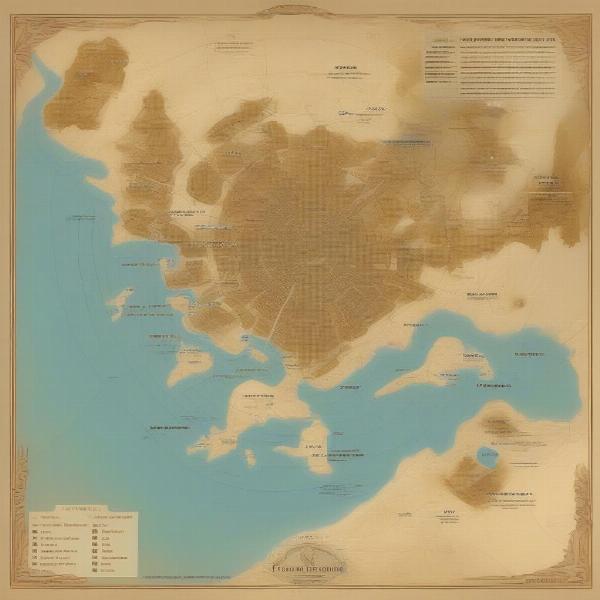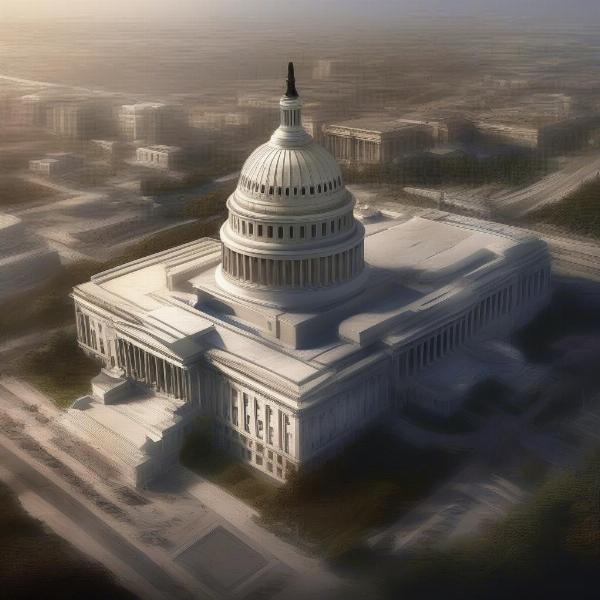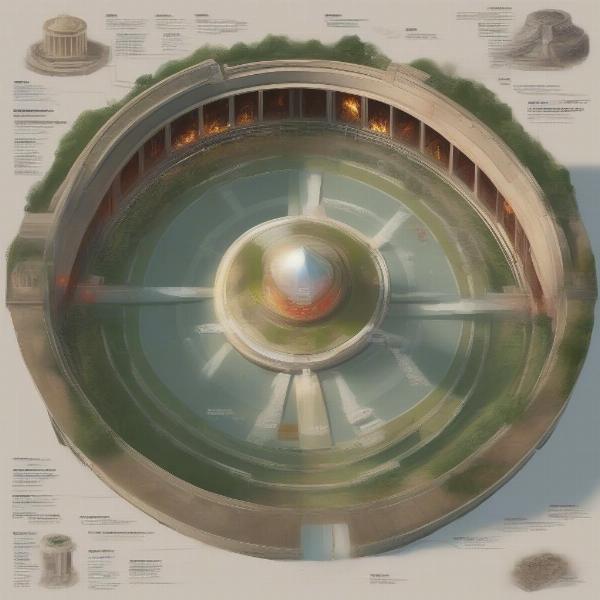The compelling dystopian world of The Hunger Games leaves many wondering, is Panem the only country? The books and films focus intensely on Panem’s internal struggles, leaving the world outside its borders shrouded in mystery. Let’s delve into this question and explore the geopolitical landscape of this fictional universe.
Unraveling the Geography of Panem: A Post-Apocalyptic North America
The Hunger Games takes place in a post-apocalyptic North America, ravaged by unspecified disasters. What remains is Panem, a nation built from the ashes. The Capitol, a gleaming city of advanced technology and opulent excess, rules over twelve districts, each responsible for supplying a specific resource or commodity. This rigid structure and the stark contrast between the Capitol’s wealth and the districts’ poverty fuel the central conflict of the series. But what lies beyond Panem’s borders? The narrative offers only tantalizing glimpses.
Hints and Speculations About the Outside World
While the existence of other nations isn’t explicitly confirmed, the narrative drops hints suggesting Panem isn’t alone. References to “the dark days” and “the rebellion” imply a history that extends beyond Panem’s current borders. These fragmented memories suggest a larger world that collapsed, leaving Panem as the dominant, perhaps even the sole, surviving power.
 Panem Map Showing District Locations
Panem Map Showing District Locations
The Capitol’s Control: Information Suppression and Isolation
The Capitol maintains a tight grip on information, keeping the districts ignorant of the outside world. This control is crucial for maintaining order and preventing further uprisings. The lack of communication between districts and the absence of external news sources contribute to the perception that Panem exists in isolation. Could this be a deliberate strategy by the Capitol to maintain its power?
The Role of Propaganda in Shaping Panem’s Worldview
The Hunger Games themselves serve as a brutal reminder of the Capitol’s power and a tool to quell dissent. The annual spectacle reinforces the idea that Panem is all that remains, a self-contained world where the Capitol reigns supreme. This carefully crafted narrative leaves little room for questions about other countries or alternative ways of life.
 Capitol Building Symbolizing Panem's Power
Capitol Building Symbolizing Panem's Power
Exploring the Possibilities: Could Other Nations Exist?
Despite the lack of concrete evidence, the possibility of other nations existing beyond Panem remains intriguing. Perhaps these nations are also struggling to rebuild after the global catastrophe. Or perhaps they have achieved a different kind of stability, one that doesn’t involve the oppressive regime of Panem. The ambiguity surrounding the outside world allows for endless speculation and fan theories.
The Silence of the Narrative: A Deliberate Choice
The deliberate silence of the narrative about the outside world adds to the story’s mystique and allows readers to draw their own conclusions. It reinforces the sense of isolation and claustrophobia experienced by the characters within Panem. This narrative choice also highlights the Capitol’s control over information and its ability to shape the reality perceived by its citizens.
“The ambiguity surrounding the world outside Panem is a powerful narrative tool,” says Dr. Amelia Hawthorne, a leading expert in dystopian literature. “It allows readers to project their own fears and anxieties onto the unknown, making the story even more impactful.”
 Hunger Games Arena with District Tributes
Hunger Games Arena with District Tributes
Beyond Panem’s Borders: Fan Theories and Interpretations
The absence of definitive answers about the outside world has fueled numerous fan theories and interpretations. Some believe that other nations exist but are too weak or fearful to interact with Panem. Others speculate that Panem is truly the last bastion of civilization. These diverse interpretations contribute to the richness and complexity of The Hunger Games universe.
The Importance of Hope in a Dystopian World
The question of whether other countries exist becomes a symbol of hope. The possibility of a different world, a world beyond the Capitol’s control, offers a glimmer of hope for the oppressed citizens of Panem. This hope, however tenuous, fuels the desire for rebellion and change.
“The very act of questioning the existence of other countries represents a spark of defiance,” explains Dr. Hawthorne. “It suggests that the characters, and the readers, refuse to accept the limited reality presented by the Capitol.”
Is Panem Alone? A Question That Resonates
Ultimately, the question of whether Panem is the only country remains unanswered. This ambiguity is a crucial element of the story, adding to its depth and complexity. It invites readers to contemplate the nature of power, control, and the importance of hope in a dystopian world. What do you think? Share your thoughts and theories in the comments below. Let’s discuss the world beyond Panem together.
The Hunger Games: A Deeper Look at Society and Control
This section explores the societal structures within Panem and the mechanisms of control employed by the Capitol. We delve into the social hierarchy, economic disparities, and the use of propaganda to maintain order. This analysis offers a deeper understanding of the dynamics at play within Panem and the factors that contribute to its dystopian nature.
Exploring Dystopian Literature: Themes and Parallels
This section examines The Hunger Games within the broader context of dystopian literature. We explore common themes and motifs found in dystopian narratives, such as government control, social inequality, and the suppression of individual freedom. We also draw parallels between The Hunger Games and other notable dystopian works, highlighting the shared concerns and warnings they present.
Conclusion: The Enduring Mystery of the Outside World
The question of whether Panem is the only country in The Hunger Games remains a compelling mystery. While the narrative focuses primarily on the internal struggles within Panem, the hints and ambiguities surrounding the outside world spark our imagination and invite us to consider the broader implications of this dystopian setting. The lack of a definitive answer enhances the story’s impact and encourages us to contemplate the nature of power, control, and the enduring importance of hope. What lies beyond Panem’s borders? The answer, perhaps, lies in our own interpretations.
FAQ
- What is Panem? Panem is the post-apocalyptic nation where The Hunger Games takes place.
- Why is the outside world a mystery? The narrative deliberately omits details about the world beyond Panem, adding to the story’s mystique.
- Are there any hints about other countries? Vague references to “the dark days” and “the rebellion” suggest a history beyond Panem.
- Why doesn’t the Capitol reveal information about the outside world? Controlling information is crucial for the Capitol to maintain its power and suppress dissent.
- What are some fan theories about the outside world? Theories range from the existence of other struggling nations to Panem being the last bastion of civilization.
- Why is this question important? The possibility of other countries represents hope for the oppressed citizens of Panem.
- What does the ambiguity about the outside world symbolize? It symbolizes the Capitol’s control and the characters’ yearning for a different reality.

